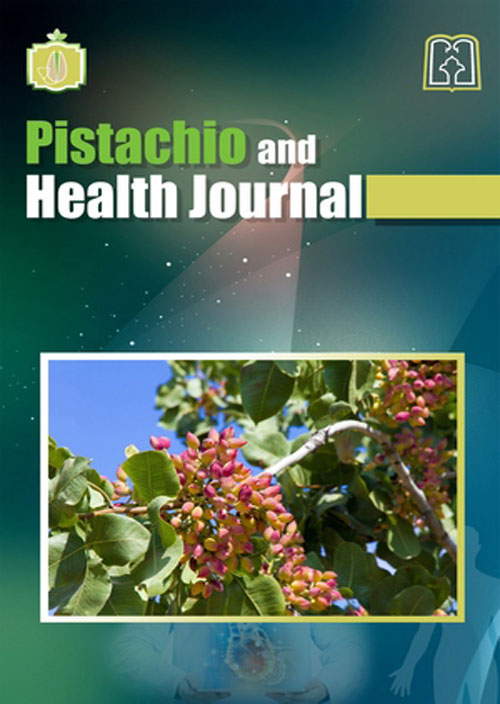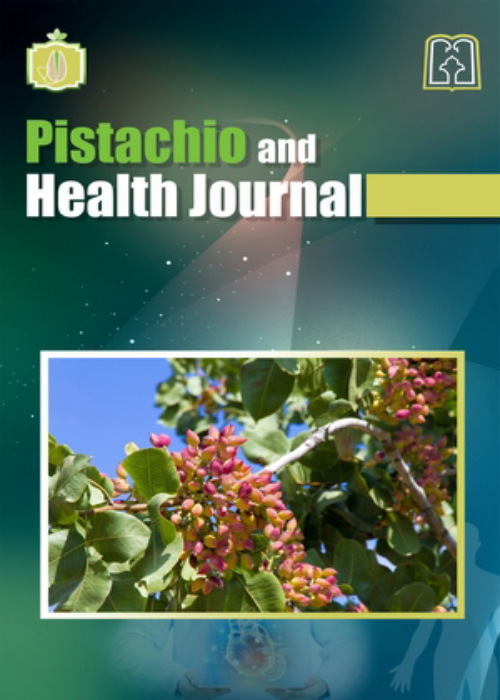فهرست مطالب

Pistachio and Health Journal
Volume:5 Issue: 2, Spring 2022
- تاریخ انتشار: 1401/08/12
- تعداد عناوین: 8
-
Pages 1-3
-
Pages 4-13Background
Heat-shock proteins (HSPs) are ATP-dependent chaperones conserved from bacteria to eukaryotes. In plants, they are necessary to control their normal growth, development, and immune responses to environmental stimuli. The present study aimed to comprehensively analyze the HSP gene family in pistachio and six other plants.
Materials and methodsAn alignment sequence of full-length proteins of Arabidopsis, pistachio, orange, corn, date, pine, and pea was prepared using MUSCLE and saved in the ClustalW format. Their phylogenetic analysis was conducted using the MEGA 6.0 program, with 1000 bootstrap replications. An unrooted Maximum-Likelihood was established by the Jones-Taylor-Thornton (JTT) model and the same alignment file. Conserved motifs in putative protein sequences were recognized by the MEME program using default parameters. In order to predict the structure of proteins, the phyre2 web server was used.
ResultsAccording to the sequence alignment, conserved amino acid sequences showed that pistachio and pea shared the greatest similarity. Besides, pistachio and orange showed the least identity. The phylogenetic tree revealed that within the same sub-families, the most closely related StHsp70 members assigned similar exon/intron structures and intron numbers. Additionally, 18 putative conserved motifs were identified.
ConclusionThe present survey indicated the functional characteristics of the HSP genes and provided basic information on pistachio and other plants with a high commercial and economic value for further studies on their biological functions.
Keywords: HSPs proteins, Jones-Taylor-Thornton, MEGA, Muscle, MEME -
Pages 14-26Introduction
The Indian meal moth, Plodia interpunctella Hubner, is an important pest in pistachio stores which causes great damage to this product. Considering the importance of human health and protecting the environment, it is important to reduce the use of pesticides in pest control. One of the non-chemical methods to control this pest is the use of biological control agents such as entomopathogenic fungi combined with mineral and natural materials such as diatomaceous earth and kaolin.
Materials and MethodsThe current study investigated the lethal effect of Metarhizium anisopliae alone and in combination with diatomaceous earth and kaolin at controlled conditions (25±1oC, RH 85±5%, and a photoperiod of 16: 8 h L: D). The dipping test was conducted on the first instar larvae of Plodia interpunctella grown on pistachios of the round variety.
ResultsThe results showed that the lethal concentration of M. anisopliae (0.5×106 conidia ml-1 ) caused 15, 27, 42, 50, and 55% mortality in the pest population after 24, 48, 72, 96, and 120 hours, respectively. Also, 20, 30, 40, 52, and 60% mortality were observed at LC50= 486.5 mg/kg of diatomaceous earth, respectively. Moreover, kaolin powder at LC50= 900 mg/kg caused 22.5, 32.5, 40, 50 and 60% mortality, respectively. However, the mortality in M. anisopliae treatment in combination with diatomaceous earth and kaolin powder in lethal concentration indicated the additive effect of M. anisopliae.
ConclusionThe results suggested that M. anisopliae, diatomaceous earth, and kaolin powder can be used as alternatives to chemical pesticides in the integrated management of this stored pest.
Keywords: biological control, Insect pathogenic fungi, Storage pests -
Pages 27-39Introduction
In traditional agriculture, the decision to use pesticides is made based on various factors, including their effect on specific pests, their usage costs, a crop's economic value, and pesticide- arisen risks, such as environmental pollution. On the other hand, the main goal of organic farming is to prevent environmental degradation and health risks by reducing or eliminating the use of chemical pesticides. The present study investigates the current status and role of non-chemical methods to control pistachio pests.
Materials and methodsThe information was collected using a questionnaire from 286 pistachio orchards selected by a random sampling method. Analysis of variance was used to measure the effect of non-chemical methods on the use of pesticides. The logit model was used to investigate the effect of socio-economic factors on the choice of pest management model.
ResultsThe results indicated that the non-chemical control methods used by farmers were not successful and were used only as a complement to those of chemicals. In contrast, due to the low quality and cheap pesticides on the market, spraying up to 18 times a year is economical for pistachio orchards.
ConclusionGiven the high benefits of controlling pistachio pests, there is a great economic incentive to use pesticides. Therefore, appropriate tools are required to be defined and implemented if other goals such as sustainability and protection of the environment, as well as producing a healthy product, are to be pursued besides economic benefits.
Keywords: Pistachio, Pest Management, Non-chemical control -
Pages 40-48Introduction
Agricultural wastes are low-cost absorbents which play an important role in removing waste disposal costs and also in helping to protect the environment. This investigates the efficiency and absorption capacity of various types of adsorbents obtained from hard pistachio shells in removing hazardous pollutants.
Materials and methodsThe present study is a systematic review which examined articles related to the use of agricultural wastes obtained from hard pistachio shells as absorbents to remove pesticides, drugs, and dyes in various websites such as PubMed, Google Scholar, Scopus, ISI Web of Science published from 2010 to 2020.
ResultsAdsorbents obtained from the hard shell of pistachio have been considered an adsorbent for water purification for many years. Given the physical and chemical properties of pistachio shell such as high absorption capacity, the presence of various special functional groups, and the modifiability of its structure, it has shown a remarkable performance in removing a wide range of pollutants by the surface absorption method. The obtained results showed that the absorption capacity of the adsorbent could be increased by using temperature processes, chemicals and waves. It was also found that the adsorption process using pistachio shell follows the Langmuir isotherm and the pseudo-second-order kinetics in all cases.
ConclusionPistachio waste has a good performance as an absorbent to remove pollutants and can be used raw or modified in water and wastewater treatment. Also, the results showed that pistachio shell is a good precursor for the production of activated carbon.
Keywords: Pistachio shell, agricultural wastes management, removing pollutants -
Pages 49-57Introduction
Pistachio is one of the top export products of Iran,. Hence, due to groundwater depletion and as a result of salinization of soil and water used for agriculture, a solution should be sought to increase the tolerance of the plant under salinity stress .
Materials and MethodsIn order to investigate the effect of various priming treatments , an experiment was conducted in the form of a factorial design with five treatments and three replications in the greenhouse of the Rafsanjan Pistachio Research Institute in 2020. Priming treatments include control (without priming), P in two concentrations of 100 (P1) and 200 (P2) mg/liter, potassium nitrate (KNO3) in two concentrations of 100 and 200 mg/liter, and the salinity stress treatments were at three levels of 6, 12, and 18 deciSiemens/meter (dS/m). The traits to be measured were diameter and stem height after stress, fresh and dry weight of shoots and roots, and germination percentage.
ResultsThe results of the research showed that salinity significantly reduced the germination percentage at all three levels. The highest dry weight of shoots and roots was due to the interaction of P2 and salinity level of 12 dS/m. P2 in seed priming caused an increase in all investigated traits.
ConclusionIn general, it can be concluded that priming with tested materials can reduce salinity to an acceptable and satisfactory level .
Keywords: priming, Salinity, Stress, Pistachio seeds -
Pages 58-66Introduction
Common pistachio psyllid Agonoscena pistaciae Burkhardt & Lauterer (Hem.: Psyllidae) is one of the main pests of pistachio trees in Iran. Given the risks of excessive use of chemical pesticides, it seems that one of the methods to minimize pesticide pollution is to use plant and mineral compounds.
Materials and methodsIn this research, the mineral composition of diatomaceous earth and the formulated compounds of chinaberry tree (Melia Azedarach) plant extract (A: chinaberry extract + soap and B: chinaberry extract + potassium silicate) were used to investigate the mortality of nymphs and spawning rate.
ResultsInvestigating the results indicated that the leaves treated with chinaberry extract + soap with a concentration of 3000 mg/liter following 5 and 10 days and the combination of chinaberry extract + soap (3000 mg/liter) and diatomaceous earth (10000 mg) g/liter) following 5 days were reported to have the highest mortality of nymphs and the lowest spawning rate compared to the control group. Moreover, the results have indicated that the spawning rate of the leaves treated with the combination of chinaberry extract + potassium silicate and the combination of chinaberry extract + soap and diatomaceous earth after 15 days is not significantly different compared to that of the control.
ConclusionGiven the favorable effect of the chinaberry + soap and the combination of chinaberry extract + soap and diatomaceous earth in reducing the number of nymphs and the spawning rate, it seems that spraying pistachio trees with these compounds can properly control the psyllid population.
Keywords: common pistachio psyllid, diatomaceous earth, neem plant extract, spawning, hatching index -
Pages 67-74Background
Due its special geographical location and being located in the center of the country, Ardakan has unique conditions, and despite having severe desert conditions, it has dynamic and diverse agriculture. Meanwhile, pistachio cultivation has long been flourishing in this city; with 8 thousand hectares of pistachio orchards, most of which are seedlings, it is considered as one of the important genetic sources of this product in the country. Despite the unfavorable conditions in terms of water, air and soil, the cultivated area of this crop has not decreased in recent years, although there are many challenges in the production of this crop in Ardakan.
Materials and MethodsThe problems and challenges of the pistachio industry in Ardakan region were investigated using 18 articles and books.
ResultsAmong the most important of these challenges are issues such as small holdings, quantitative and qualitative problems of agricultural water, lack of proper and timely management of pests and diseases, yellowing of pistachio trees, simultaneous cultivation of pistachio with other crops, spring frosts, heat stress and hot spring and summer winds, failing to provide due care for the orchards, improper storage of pistachios, lack of proper development of processing industries,environmental pollution, lack of development of the only existing pistachio research station, and insufficient coordination between related departments. In order to reduce the problems of this product, it is required that the authorities have a strategic attitude towards the pistachio production industry in Ardakan. In addition, the awareness of gardeners is required to be promoted. Also, the productivity of current water resources and access to new and transitional water resources are required to be increased.
Conclusionsit is of high significance to plan and pay due attention to applied research in order to solve the problems of pistachio crops in the region.
Keywords: challenge, Pistachio, Yazd province


